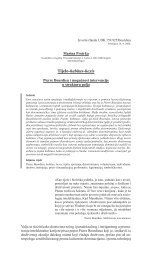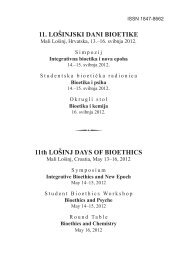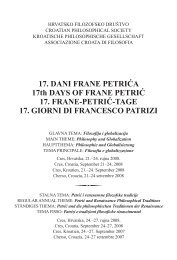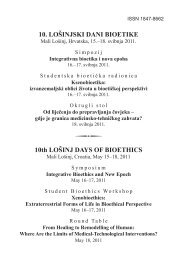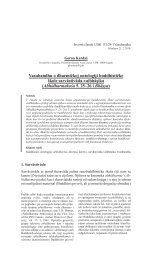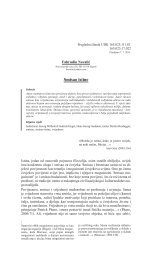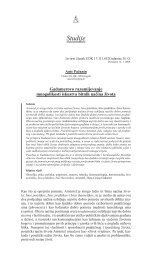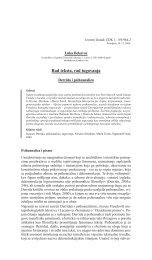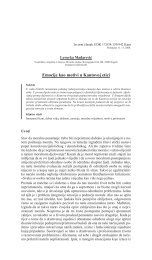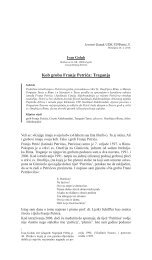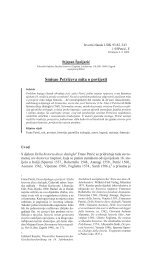Programska knjižica - Hrvatsko filozofsko društvo
Programska knjižica - Hrvatsko filozofsko društvo
Programska knjižica - Hrvatsko filozofsko društvo
You also want an ePaper? Increase the reach of your titles
YUMPU automatically turns print PDFs into web optimized ePapers that Google loves.
the famous Ragusan states (n. 19) and hence sings: “You, Newton, shall be my<br />
greater deity” (Tu maius mihi numen eris, Newtone, VI,10), understandably,<br />
than those from the mythology of the ancients. Underlying Bošković’s epic<br />
is not merely the celebration of Newton’s work in verses and notes, but also<br />
exhaustive description of Newton’s contributions to optics, primarily the key<br />
experiment with the prisms (nn. 49–57).<br />
In addition, Bošković clearly defines his views on Newton’s philosophy<br />
of science and offers his own as a “method of right philosophizing” (methodus<br />
recte philosophandi, n. 28): “Nature is researched by observations and<br />
experiments,” in which observations are applied in astronomy and natural history,<br />
and experiments in experimental physics and chemistry. Following in the<br />
footsteps of Newton and his famous dictum Hypotheses non fingo, Bošković<br />
too is against the application of the “entirely arbitrary hypotheses” (hypotheses<br />
penitus arbitrariae). He does not envisage the path to genuine theory in physics<br />
as linear progress, but it also passes “through many errors” (per errores<br />
etiam plurimos).<br />
Having acknowledged in London that his scientific works had not reached<br />
the British Isles, in the notes Bošković attempts to introduce the British scholarly<br />
milieu to the continuity and diversity of his scientific work. Quite expectedly,<br />
he recurrently refers to his important treatise De lumine (1748), as well<br />
as to Carlo Benvenuti’s treatise under the same title, who followed and proved<br />
Bošković’s ideas (n. 16). He describes his participation in the 1752 competition<br />
of the Académie des Sciences in Paris about the perturbations of Jupiter<br />
and Saturn (n. 5). He draws attention to his most significant contribution to<br />
geophysics: the shape of the Earth is “completely irregular,” as he expounded<br />
in the fifth part of his geodetic report De litteraria expeditione per Pontificiam<br />
ditionem (1755) (n. 8). He makes two references to the achievements of his<br />
theory of forces and the work Philosophiae naturalis theoria (1758) printed<br />
in Vienna (nn. 45, 49). Moreover, he brings to mind his hypothesis from 1748,<br />
by which the refraction of light depends on the multitude and distribution of<br />
points which compose the particle of light (n. 23).<br />
Bošković also refers to “Notae ad iridem” (1747), his notes accompanying<br />
the poem of his professor Carlo Noceti, in which he wrote about the application<br />
of prism in optical research (n. 29). He outlines the major contributions in<br />
his Supplementa to the epic Philosophia recentior by Benedikt Stay: in the first<br />
volume (1755) he expounded on the general properties of bodies and the force<br />
of inertia, and in the second (1760) he provided a comprehensive survey of<br />
astronomy (n. 28). Finally, in his revision of the notes in the Paris edition of his<br />
epic in 1779, Bošković draws attention to the book which is his main contribu-<br />
155



